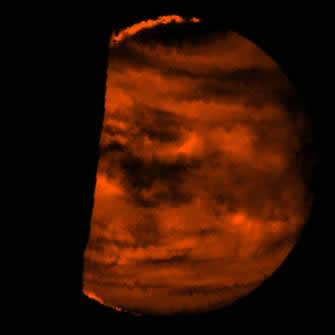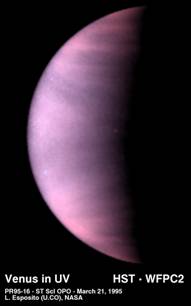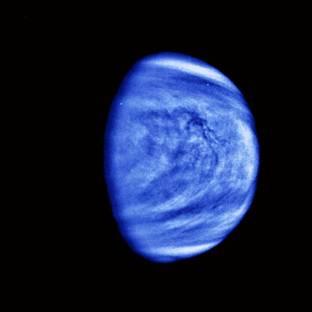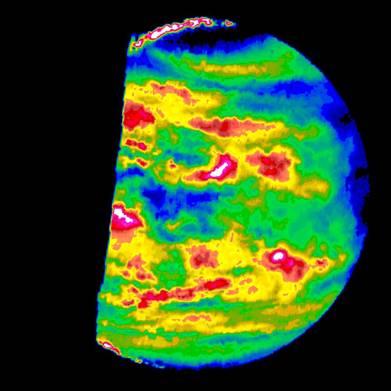In the 1960’s Venus’ clouds were first studied by spectroscopy and polarization. On the basis of this, the presence of sulphuric acid was only clearly established in 1973, and confirmed by in-situ analyses throughout many Soviet missions from Venera-12 (1978) and the American mission Pioneer Venus (1979).
Clouds in the higher atmosphere
Particles, in liquid phase, form at very high altitudes, at the level of the top of the upper cloud layer, where the ultraviolet radiation from the sun leads to the photolysis on some atmospheric constituents on Venus.
In particular, SO2 gas forms SO3 in a reaction with O, coming from the photolysis of CO2, and then makes H2SO4 from H2O, which passes to liquid state due to the partial pressure of the sulphuric gases in the surrounding gas.
Clouds in the low atmosphere
In the low atmosphere, we can see the decomposition of fine droplets of sulphuric acid H2SO4 migrating through the stratified cloud structure at the slow speed of about 1 mms-1. They are vapourised when they reach the hotter layers of the base of the clouds, at about 40km altitude.

The view shows the middle atmosphere (corresponding to altitudes 50-55km above the surface) as turbulent and cloudy. The red colour indicates the heat emitted by the lower atmosphere, shining through the cloud layer, which seem 10 times darker than the brighter holes between the clouds. This cloud layer is at a temperature of -30°C. The clouds seem fluffy but form large compact groups; in the north they form filaments oriented from the east to the west and at the poles they form a complete blanket.
Fascinating UV phenomenon in the atmosphere of Venus
Ultraviolet observations of the cloud layer revealed an intriguing phenomenon. Some zones absorb half of the solar energy received by the planet and reemit it in the form of ultraviolet radiation.
Many explanations of varying levels of fantasy, where put forward: at 50km altitude microbes could be feeding on sulphuric acid and using UV light in an exotic photosynthetic process to extract energy. This is a hypothesis for extreme exobiology but to verify it, one would have to go there with balloon probes.




